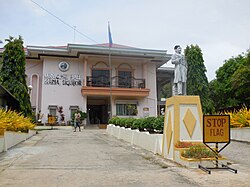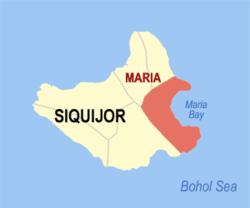Maria, Siquijor
Maria | |
|---|---|
| Municipality of Maria | |
 Maria Town Hall | |
 Map of Siquijor with Maria highlighted | |
Location within the Philippines | |
| Coordinates: 9°11′46″N 123°39′18″E / 9.196°N 123.655°E | |
| Country | Philippines |
| Region | Central Visayas |
| Province | Siquijor |
| District | Lone district |
| Barangays | 22 (see Barangays) |
| Government | |
| • Type | Sangguniang Bayan |
| • Mayor | Roselyn T. Asok (PDPLBN) |
| • Vice Mayor | Ivy Dan M. Samson (PDPLBN) |
| • Representative | Zaldy S. Villa |
| • Municipal Council | Members |
| • Electorate | 11,128 voters (2022) |
| Area | |
| • Total | 53.37 km2 (20.61 sq mi) |
| Elevation | 23.8 m (78.1 ft) |
| Highest elevation | 448 m (1,470 ft) |
| Lowest elevation | 0 m (0 ft) |
| Population (2020 census)[4] | |
| • Total | 14,385 |
| • Density | 270/km2 (700/sq mi) |
| • Households | 3,545 |
| Economy | |
| • Income class | 5th municipal income class |
| • Poverty incidence | 24.90 |
| • Revenue | ₱ 80.14 million (2020) |
| • Assets | ₱ 100.2 million (2020) |
| • Expenditure | ₱ 70.49 million (2020) |
| • Liabilities | ₱ 37.56 million (2020) |
| Service provider | |
| • Electricity | Province of Siquijor Electric Cooperative (PROSIELCO) |
| Time zone | UTC+8 (PST) |
| ZIP code | 6229 |
| PSGC | |
| IDD : area code | +63 (0)35 |
| Native languages | Cebuano Tagalog |
| Patron saint | Our Lady of Divine Providence |
Maria, officially the Municipality of Maria (Cebuano: Lungsod sa Maria; Tagalog: Bayan ng Maria), is a 5th class municipality in the province of Siquijor, Philippines. According to the 2020 census, it has a population of 14,385.[4]
Maria is 32 kilometres (20 mi) from Siquijor.
Geography[edit]

Barangays[edit]
Maria is politically subdivided into 22 barangays. Each barangay consists of puroks and some have sitios.
| PSGC | Barangay | Population | ±% p.a. | |||
|---|---|---|---|---|---|---|
| 2020[4] | 2010[6] | |||||
| 076104001 | Bogo | 5.9% | 851 | 739 | 1.42% | |
| 076104002 | Bonga | 3.9% | 555 | 459 | 1.92% | |
| 076104003 | Cabal‑asan | 2.7% | 389 | 357 | 0.86% | |
| 076104004 | Calunasan | 4.5% | 643 | 641 | 0.03% | |
| 076104005 | Candaping A | 4.0% | 582 | 448 | 2.65% | |
| 076104006 | Candaping B | 4.8% | 684 | 591 | 1.47% | |
| 076104007 | Cantaroc A | 3.2% | 462 | 385 | 1.84% | |
| 076104008 | Cantaroc B | 3.5% | 501 | 411 | 2.00% | |
| 076104009 | Cantugbas | 2.9% | 412 | 400 | 0.30% | |
| 076104010 | Lico‑an | 3.4% | 496 | 529 | −0.64% | |
| 076104011 | Lilo‑an | 10.1% | 1,459 | 1,470 | −0.08% | |
| 076104013 | Logucan | 4.5% | 647 | 557 | 1.51% | |
| 076104012 | Looc | 3.4% | 489 | 528 | −0.76% | |
| 076104014 | Minalulan | 5.9% | 843 | 703 | 1.83% | |
| 076104015 | Nabutay | 7.0% | 1,000 | 718 | 3.37% | |
| 076104016 | Olang | 4.9% | 701 | 592 | 1.70% | |
| 076104017 | Pisong A | 2.5% | 366 | 292 | 2.28% | |
| 076104018 | Pisong B | 1.7% | 249 | 293 | −1.61% | |
| 076104019 | Poblacion Norte | 8.0% | 1,153 | 1,170 | −0.15% | |
| 076104020 | Poblacion Sur | 4.6% | 656 | 675 | −0.29% | |
| 076104021 | Saguing | 5.6% | 803 | 946 | −1.63% | |
| 076104022 | Sawang | 3.1% | 444 | 479 | −0.76% | |
| Total | 14,385 | 13,383 | 0.72% | |||
Climate[edit]
| Climate data for Maria, Siquijor | |||||||||||||
|---|---|---|---|---|---|---|---|---|---|---|---|---|---|
| Month | Jan | Feb | Mar | Apr | May | Jun | Jul | Aug | Sep | Oct | Nov | Dec | Year |
| Mean daily maximum °C (°F) | 29 (84) |
30 (86) |
31 (88) |
32 (90) |
31 (88) |
30 (86) |
30 (86) |
30 (86) |
30 (86) |
29 (84) |
29 (84) |
29 (84) |
30 (86) |
| Mean daily minimum °C (°F) | 22 (72) |
22 (72) |
22 (72) |
23 (73) |
24 (75) |
24 (75) |
24 (75) |
24 (75) |
24 (75) |
24 (75) |
23 (73) |
23 (73) |
23 (74) |
| Average precipitation mm (inches) | 26 (1.0) |
22 (0.9) |
28 (1.1) |
41 (1.6) |
95 (3.7) |
136 (5.4) |
147 (5.8) |
126 (5.0) |
132 (5.2) |
150 (5.9) |
98 (3.9) |
46 (1.8) |
1,047 (41.3) |
| Average rainy days | 7.5 | 6.7 | 8.9 | 10.4 | 21.6 | 25.6 | 26.3 | 25.0 | 24.1 | 26.2 | 19.2 | 12.1 | 213.6 |
| Source: Meteoblue[7] | |||||||||||||
Demographics[edit]
| Year | Pop. | ±% p.a. |
|---|---|---|
| 1903 | 6,499 | — |
| 1918 | 8,477 | +1.79% |
| 1939 | 8,722 | +0.14% |
| 1948 | 8,547 | −0.22% |
| 1960 | 9,335 | +0.74% |
| 1970 | 9,942 | +0.63% |
| 1975 | 10,778 | +1.63% |
| 1980 | 10,951 | +0.32% |
| 1990 | 11,140 | +0.17% |
| 1995 | 11,106 | −0.06% |
| 2000 | 12,275 | +2.17% |
| 2007 | 12,974 | +0.77% |
| 2010 | 13,383 | +1.14% |
| 2015 | 13,828 | +0.62% |
| 2020 | 14,385 | +0.78% |
| Source: Philippine Statistics Authority[8][6][9][10] | ||
Economy[edit]

Poverty Incidence of Maria
Graphs are unavailable due to technical issues. There is more info on Phabricator and on MediaWiki.org. |
Education[edit]
The public schools in the town of Maria are administered by one school district under the Schools Division of Siquijor.
Elementary schools:
- Bogo Elementary School — Bogo
- Candaping Elementary School — Candaping B
- Cantaroc Elementary School — Cantaroc B
- Cantugbas Elementary School — Cantugbas
- Lico-an Elementary School — Lico-an
- Lilo-an Elementary School — Lilo-an
- Logucan Elementary School — Logucan
- Minalulan Elementary School — Minalulan
- Nabutay Elementary School — Nabutay
- Pisong A Elementary School — Pisong A
- Pisong B Elementary School — Pisong B
High schools:
- Candaping National High School — Candaping B
Integrated schools:
- Maria Integrated School (formerly Maria CS) — Poblacion Norte
References[edit]
- ^ Municipality of Maria | (DILG)
- ^ "2015 Census of Population, Report No. 3 – Population, Land Area, and Population Density" (PDF). Philippine Statistics Authority. Quezon City, Philippines. August 2016. ISSN 0117-1453. Archived (PDF) from the original on May 25, 2021. Retrieved July 16, 2021.
- ^ Error: Unable to display the reference properly. See the documentation for details.
- ^ a b c Census of Population (2020). "Region VII (Central Visayas)". Total Population by Province, City, Municipality and Barangay. Philippine Statistics Authority. Retrieved 8 July 2021.
- ^ "PSA Releases the 2018 Municipal and City Level Poverty Estimates". Philippine Statistics Authority. 15 December 2021. Retrieved 22 January 2022.
- ^ a b Census of Population and Housing (2010). "Region VII (Central Visayas)" (PDF). Total Population by Province, City, Municipality and Barangay. National Statistics Office. Retrieved 29 June 2016.
- ^ "Maria: Average Temperatures and Rainfall". Meteoblue. Retrieved 28 April 2020.
- ^ Census of Population (2015). "Region VII (Central Visayas)". Total Population by Province, City, Municipality and Barangay. Philippine Statistics Authority. Retrieved 20 June 2016.
- ^ Censuses of Population (1903–2007). "Region VII (Central Visayas)". Table 1. Population Enumerated in Various Censuses by Province/Highly Urbanized City: 1903 to 2007. National Statistics Office.
{{cite encyclopedia}}: CS1 maint: numeric names: authors list (link) - ^ "Province of Siquijor". Municipality Population Data. Local Water Utilities Administration Research Division. Retrieved 17 December 2016.
- ^ "Poverty incidence (PI):". Philippine Statistics Authority. Retrieved December 28, 2020.
- ^ "Estimation of Local Poverty in the Philippines" (PDF). Philippine Statistics Authority. 29 November 2005.
- ^ "2003 City and Municipal Level Poverty Estimates" (PDF). Philippine Statistics Authority. 23 March 2009.
- ^ "City and Municipal Level Poverty Estimates; 2006 and 2009" (PDF). Philippine Statistics Authority. 3 August 2012.
- ^ "2012 Municipal and City Level Poverty Estimates" (PDF). Philippine Statistics Authority. 31 May 2016.
- ^ "Municipal and City Level Small Area Poverty Estimates; 2009, 2012 and 2015". Philippine Statistics Authority. 10 July 2019.
- ^ "PSA Releases the 2018 Municipal and City Level Poverty Estimates". Philippine Statistics Authority. 15 December 2021. Retrieved 22 January 2022.
External links[edit]
Wikimedia Commons has media related to Maria.



